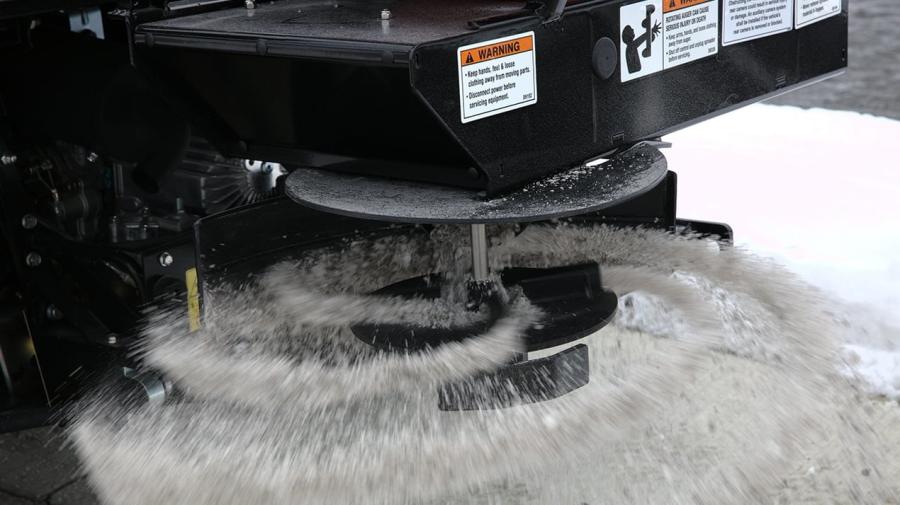Check on proper spreader position and support, ensuring it is bolted to the vehicle frame and doesn’t require any additional reinforcements unless completely necessary for the type of unit being used.
Maintaining machinery and parts all year round is crucial to your equipment working efficiently when snow season arrives, but can be just as easily overlooked when it comes to spreaders. Ensuring they receive the attention they need ahead of, during and after the season will help provide a longer life to your snow equipment and result in better operations.
Your manufacturer or dealer has the most updated information for the specifics on how to maintain spreaders, but here are a few general recommendations.
First Look
Ensure all spreader controls are turned off before beginning any inspections. Given the number of moving parts involved, make personal safety a priority when operating equipment. Review the owner's manual for specific instructions on your spreader and when in doubt, call the dealer or manufacturer helpline for insights on how to best care for your spreader. Hours of technical expertise have gone into building a quality part for prolonged use but that also requires you doing your part in maintaining this integral piece of your equipment.
Cleaning, Fluids
Because spreaders are filled with chemicals that result in corrosion over time, cleaning out the spreader after each job is important. Irrespective of steel or polyethylene, a good cleanup is the basic starting point for any spreader maintenance exercise.
Water usually does the trick, though pressure washing warrants a keen eye to ensure no additional damage to internal and external parts and surfaces. Whether you are working with electric motors or gas engines, fluid levels should be inspected through the year based on guidelines provided in your owner's manual.
Motors, Spinners
Check for corrosion and buildup when cleaning motors and connectors as well as any material collecting around moving parts such as spinners and bearings. Look at belts, chains and electrical systems for any immediate repairs or replacements to be addressed now rather than when your spreader is in operation during the peak of winter.
Western has provided resources on its site — westernplows.com/resource-article-category/spreader-maintenance/ — addressing spreader maintenance and inspection that is useful for any equipment owner or operator.
Greasing All Components
All through the season, rollers, bearings, chains, electric plugs, hoppers, spinners and other moving parts must be lubricated. This goes without saying, but to keep parts working together smoothly, this is an important and often ignored step in caring for spreaders.
Some models might require more greasing than others, but once more it's the owner's manual to the rescue to guide on all the lubrication points, how much and how often. And always use dielectric grease for all electric-powered spreaders to help protect electrical connections.
Tightening Belts, Chains
Ensure the tension between all moving parts is correctly adjusted for best performance, whether you use hopper or tailgate spreaders. But remember that overly tightened or slack parts will only lead to damaged components so be mindful of how to adjust, which parts to adjust, and by how much. Check that there is no material trapped between parts and all parts are secure per manufacturer guidelines. Many brands have instructional videos online and provide training to operators to ensure this is done correctly.
Spreader Mounting
Check on proper spreader position and support, ensuring it is bolted to the vehicle frame and doesn't require any additional reinforcements unless completely necessary for the type of unit being used.
Also keep an eye on any tightness or adjusting for fasteners and straps, and ensure vehicle battery, charging systems and lights are functioning properly.
Fisher Engineering provides a detailed checklist for pre-trip spreader inspection for safe operations along with a printable version you can tear out and save for future use. This information is available at fisherplows.com/wp-content/uploads/2021/01/t-t_1019_spreadersafety_download.pdf.
Spreader Material
Irrespective of your choice or combination of de-icing material you work with, wet material can dry up and result in buildup over time. Salt or sand that settles and becomes hard can cause spreader damage. To avoid this, use the right type of material for your spreader unit and store and handle said material properly.
No matter how good of a material delivery system or even weather-resistant cover you have installed, if the quality of your de-icing material is compromised then there can be operational issues you'll face with the spreader eventually.
Ongoing maintenance for spreaders should include a thorough checklist right from greasing connections and checking for tightness of screws and bolts, to addressing tightness of belt and motor conditions, and repairing or replacing any movable parts. Paint any bare metal surfaces, secure the unit and store it indoors in an upright position or outdoors on a raised platform and covered to protect from the elements.
A lot of the ongoing maintenance depends on the hours your spreader has put in, so check the equipment manual at regular intervals to follow the timelines specified for different maintenance or repair/replacement activities. Since spreader maintenance is somewhat simple, it doesn't always remain top of mind but is just as important as maintaining any other part or equipment in your snow season machinery. CEG
Ruksana Hussain
Ruksana Hussain is a Los Angeles, California-based award-winning journalist with 19 years' experience working with local, national and international print and digital media for consumer and trade markets. As a magazine editor and features writer, she covers a broad range of topics including construction and design, diversity and inclusion, data privacy and security, and more. She earned her bachelor's degree in sociology in India. Leisurely pursuits include traveling, random researching and attempting word puzzles of any nature.
Read more from Ruksana Hussain here.
Today's top stories




















